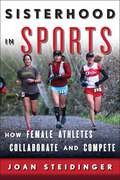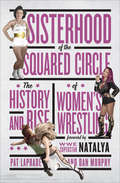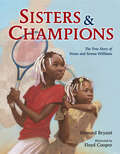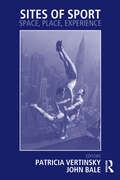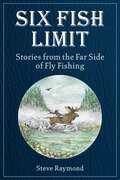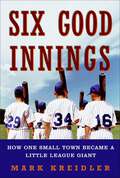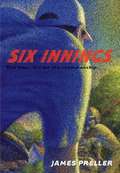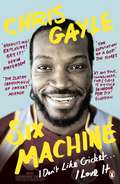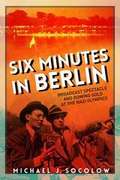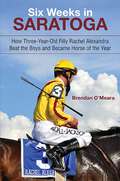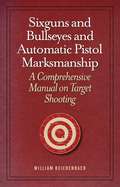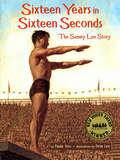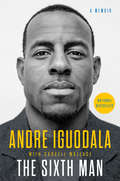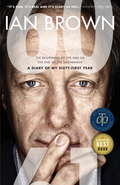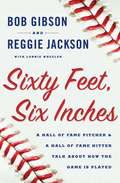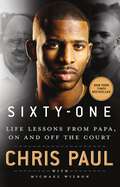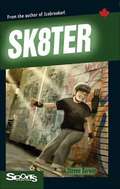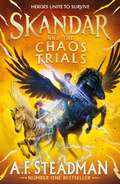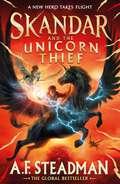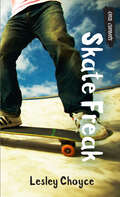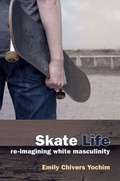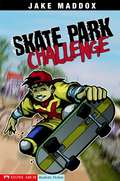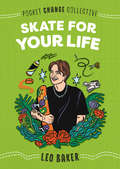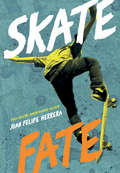- Table View
- List View
Sisterhood in Sports: How Female Athletes Collaborate and Compete
by Joan SteidingerSisterhood in Sports: How Female Athletes Collaborate and Compete tells the stories of all kinds of female athletes in a variety of sports. Their natural tendency to use talking as a primary form of communication is essential to their experiences and successes in sports. Women and girls tend to have BFFs, collaborate during periods of stress, express empathy for one another, worry about themselves and others, and desire to have fun in sports, which makes their experiences of sports and competition different from their male counterparts. Female strengths are grounded in both mind and body, and they take these strengths onto the court, field, and track. There are now dozens of studies showing how the female brain and hormones operate quite differently than those of men. This book reveals the ways in which these differences confirm that intense emotions about relationships are part of the sporting life for female competitors. Joan Steidinger uses real stories to show that women and girls compete at very high
Sisterhood of the Squared Circle: The History and Rise of Women's Wrestling
by Pat Laprade Dan MurphyA behind-the-scenes look at over a century of female wrestling, with profiles and photos: “Fascinating sports history” (Booklist). From the carnival circuit of the late 1800s to today’s main events, this book offers a look at the business of women’s wrestling with its backstage politics, real-life grudges, and incredible personalities. With more than one hundred profiles, you’ll learn about the careers of many well-known trailblazers and stars of today, including Mildred Burke, the Fabulous Moolah, Mae Young, Penny Banner, Wendi Richter, Trish Stratus, Chyna, Lita, Charlotte, Sasha Banks, and Bayley. With rare photographs and an exploration of women’s wrestling worldwide—including chapters on Japan, Mexico, England, and Australia—Sisterhood of the Squared Circle is a priceless contribution to the history of professional wrestling.
Sisters and Champions: The True Story of Venus and Serena Williams
by Howard Bryant"This one's a winner." --Chicago TribuneA 2019 ILA Teacher's Choices Reading List Selection!An inspiring picture book sports biography about two of the greatest female tennis players of all-time! Venus and Serena Williams: Best friends. Sisters. Champions.Everyone knows the names Venus & Serena Williams. They've become synonymous with championships, hard work, and with shaking up the tennis world. This inspirational true story, written by award-winning sports journalist, Howard Bryant, and brought to beautiful life by Coretta Scott Kind Award and Honor winner, Floyd Cooper, details the sisters' journey from a barely-there tennis court in Compton, CA, to Olympic gold medals and becoming the #1 ranked women in the sport of tennis. Here is a worthy ode to Venus and Serena Williams, the incredible sister duo who will go down in history as two of the greatest athletes of all time."Alive with warmth and movement, these luminous, soft-edged scenes portray the sisters gradually growing into strong, capable women. A handsome sports biography." --Booklist"There is a sharp focus in the book on the two sisters' special bond and friendship; it lies at the heart of this biography, and the women's stories are remarkable. It's high time they had their own picture book tribute."--Kirkus
Sites of Sport: Space, Place and Experience (Sport in the Global Society)
by Patricia Vertinsky and John BaleThe study of built environments such as gymnasiums, football stadiums, swimmimg pools and skating rinks provides unique information about the historical enclosure of the gendered and sexualised body, the body's capabilities, needs and desires. It illuminates the tensions between the globalising tendencies of sport and the importance of local culture and a sense of place. This collection uses spatial concepts and examples to examine the nature and development of sporting practices. At a time when the importance of spacial theories and spacial metaphors to sport is being increasingly recognised, this pioneering work on the changing landscape of sporting life will appeal to students of the history, sociology and management of sport.
Six Fish Limit: Stories From the Far Side of Fly Fishing
by Steve RaymondThis collection of six fly-fishing tales, from the best fly-fishing writer in the Pacific Northwest, includes: The Bonefisherman&’s Dilemma: Freddie Woodson planned to write a story about his trip to Sugar Cay Bonefish Resort, sell it to a fishing magazine and use the money to help pay trip expenses. But he didn&’t count on drinking too much rum, falling asleep in a hot tub, meeting a cute native girl or losing the only bonefish he managed to hook, so there was no story and no money. Now he&’s engaged in an increasing-ly acrimonious debate with his tax accountant. Freddie maintains the expenses for his trip should be tax-deductible even without income; his accountant disagrees. With the tax deadline rapidly approaching, Freddie hatches a legally questionable but highly innovative way of deriving some income from the trip. Don&’t try this on your tax return. .2. Welcome to the Stub Mountain Fly Shop: Vicki Brightman has inherited her father&’s financially struggling fly shop, now her sole means of support. Searching desperately for a way to restore the shop&’s financial health, she eventually decides that what works on fish—catching them on artificial flies—also might work on fishermen. With that in mind she concocts a longshot scheme that even she realizes has little chance of working, but with nothing else to do she goes ahead anyway—and the scheme succeeds beyond her wildest dreams. That is, as long as she doesn&’t dream about ethics. 3. The Fishlexic: World-renowned geneticist Timothy Hardhorn dreams of having a son who will grow up to become his lifelong fly-fishing partner, so when his wife becomes pregnant he manipulates the genes in the embryo to assure just such an outcome. When his son, Rodney, is born he soon surpasses his father&’s greatest expectations, but as the boy grows older Timothy notices some things about him that aren&’t, well, quite normal. Eventually he concludes that because of his genetic tinkering, his son has a peculiar form of dyslexia that afflicts only male fly fishers: He believes all the fish he catches are much bigger than they really are. 4. Diary of an Unknown Angler: Andrew Royster, dealer in rare and classic angling books, discovers an old diary containing the answer to one of fly fishing&’s greatest mysteries: the lost identity of the young woman fishing companion of Theodore Gordon, regarded by many asthe patron saint of American fly fishing. Was there something besides fishing going on between those two? Royster can&’t wait to publish the answer, hoping that by doing so he might obtain his own small slice of angling immortality. Then he discovers that once history is made and literature is written, it&’s very hard to change either. 5. The Man in Black Waders (novella): Clint Steele, the world&’s most famous fly fisher, is about to go on trial. He&’s being sued for plagiarism by Mickey Cutter, obscure author of a single angling book, who alleges Steele stole his words and used them in a book of his own. For Steele, the stakes couldn&’t be higher; he could lose lots of money, his reputation, maybe even his livelihood. When the jury returns its verdict Steele does something highly unexpected, apparently uphold-ing the jury&’s verdict. 6. The First Words Ever Written about Fly Fishing: &“I have heard of a Macedonian way of catching fish and it is this.&” Those words, attributed to the Roman scribe Claudius Aelianus, are believed the first ever written about fly fishing. But where did Aelianus hear about the Macedonian way of fishing? Where else but at a meeting of his local fishing club? OK, so it probably didn&’t really happen that way, but who knows? Maybe it did.
Six Good Innings: How One Small Town Became a Little League Giant
by Mark KreidlerIn the tradition of Friday Night Lights comes an unforgettable portrait of a small New Jersey town that became known throughout the world for the remarkable exploits of its Little League stars.Summertime in Toms River means two things: tourists and champions. The tourists head for the beaches; the 12-year-old Little League champions can be found on the baseball diamonds, where they win titles at the local, regional, and international levels.The Toms River dynasty began in the 1990s, when the team made it to the Little League World Series three times in five years and brought home a historic world championship victory in 1998. But with each passing summer in Toms River comes renewed pressure, as the latest collection of All-Stars strives to leave its mark on the town's imposing baseball legacy.In Six Good Innings, acclaimed sportswriter Mark Kreidler deftly illuminates the sometimes tense relationship between Toms River and the team that carries the town's hopes and dreams. Following the most recent juggernaut through one tumultuous All-Star season, Kreidler chronicles how the coach, John Puleo, works to strike a balance between healthy competition and bloodless ambition, and how the players themselves reckon with their own fleeting fame as they tumble headlong into adolescence.Puleo, a man with a gift for inspiring young athletes, commands a team whose recent string of successes has led to speculation that this might be the squad to extend the Toms River tradition of reaching Williamsport, site of the Little League World Series. But along the path to glory, Puleo's players will deal with unexpected injuries, a brutally difficult schedule of games, and the daunting knowledge that they have been identified throughout their region—and within the neighborhood blocks of their own baseball-crazy town—as the team to beat.With deep empathy, incisive reporting, and intimate access, Kreidler weaves the stories of the coaches, the parents, the fans, and the true boys of summer into a memorable tableau.
Six Innings: A Game in the Life
by James PrellerEarl Grubb's Pool Supplies plays Northeast Gas & Electric in the Little League championship game, while Sam, who has cancer and is in a wheelchair, has to call the play-by-play instead of participating in the game.
Six Machine: I Don't Like Cricket ... I Love It
by Chris Gayle'If the ball's there, hit it. Don't worry about what might happen. Play for the glory. Play for the six'Chris Gayle is the only man to have ever hit a six off the first ball of a Test match. But then producing the impossible is an everyday act for the West Indies legend: the first man to smash an international T20 century, the first to hit a World Cup 200, the fastest century in the history of the game. He has hit twice as many T20 sixes as any other man and scored two Test triple centuries. All this is delivered with cricket's biggest bat and an even bigger smile.Off the pitch, millions follow him on Instagram and Twitter to catch a glimpse of a globe-trotting life spent in nightclubs as much as nets, hot-tubs as often as helmets and pads. He plays late, parties later, demolishes a king-size pile of pancakes and then strolls out to mangle another hapless bowling attack.But do we really know him? Do we know what took a shy, skinny kid from a cramped tin-roofed shack in the dusty back streets of Kingston, sharing a bed with three brothers and stealing empty bottles to buy food, to the very top of the cricket world - without losing himself along the way?Outrageous and utterly original, this unputdowneable memoir will leave you reeling. Welcome to the world of the Six Machine.
Six Minutes in Berlin: Broadcast Spectacle and Rowing Gold at the Nazi Olympics
by Michael J SocolowThe Berlin Olympics, August 14, 1936. German rowers, dominant at the Games, line up against America's top eight-oared crew. Hundreds of millions of listeners worldwide wait by their radios. Leni Riefenstahl prepares her cameramen. Grantland Rice looks past the 75,000 spectators crowding the riverbank. Above it all, the Nazi leadership, flush with the propaganda triumph the Olympics have given their New Germany, await a crowning victory they can broadcast to the world. The Berlin Games matched cutting-edge communication technology with compelling sports narrative to draw the blueprint for all future sports broadcasting. A global audience--the largest cohort of humanity ever assembled--enjoyed the spectacle via radio. This still-novel medium offered a "liveness," a thrilling immediacy no other technology had ever matched. Michael J. Socolow's account moves from the era's technological innovations to the human drama of how the race changed the lives of nine young men. As he shows, the origins of global sports broadcasting can be found in this single, forgotten contest. In those origins we see the ways the presentation, consumption, and uses of sport changed forever.
Six Weeks in Saratoga: How Three-Year-Old Filly Rachel Alexandra Beat the Boys and Became Horse of the Year (Excelsior Editions)
by Brendan O'MearaSemifinalist for the 2011 Dr. Tony Ryan Book Award presented by Castleton Lyons and Thoroughbred TimesWhen Rachel Alexandra thundered to a stylish win against the boys in the 2009 Preakness Stakes, her connections came to the 141st Saratoga Race Course meeting wanting more than just another victory. They wanted Horse of the Year.Her jockey, Calvin Borel, pointed triumphantly to the three-year-old filly beneath him. Rachel Alexandra was the best horse he had ever ridden and it was his job to ensure that she and her connections didn't leave Saratoga Springs without a victory.Hall of Fame trainer and gruff New Yorker Nick Zito felt he could slay the queen. He'd take his shots with two rival horses, Da' Tara and Cool Coal Man, because, as he well knew, you can't win if you don't play.New York Racing Association president and CEO Charlie Hayward knew that Rachel Alexandra could run elsewhere and didn't have to come to Saratoga. The pressure was on him to keep this talented and magnetic filly on his property, but how far could he go without compromising his values?Then there were the other horses at the meet: the Zito-trained Commentator, eight years old and looking for one last try in the Whitney Handicap; Kentucky Derby–winner Mine That Bird, aiming to reclaim his glory if he could only stay healthy; and Summer Bird, the Belmont Stakes winner, who demanded respect.Everyone was in the twilight of their careers. What would be their legacies? How would they be remembered?Never before has the famous racing season at Saratoga been illustrated through these threads, in real time. As we follow the jockey, the trainer, and the executive, we come to understand how they, and so many other racing fans and professionals, were drawn to the magnetism of one special horse, Rachel Alexandra.All of this happens in six weeks, all at Saratoga.
Sixguns and Bullseyes and Automatic Pistol Marksmanship: A Comprehensive Manual on Target Shooting
by William ReichenbachWhether you're a target shooting enthusiast, an experienced shooter, or someone who has never held a gun, Sixguns and Bullseyes and Automatic Pistol Marksmanship will help you explore different types of handguns, fundamental shooting skills, and expert tips to gain marksmanship precision.This edition combines two classic shooting manuals from the 1930s in one volume for modern audiences. Author and gun enthusiast William Reichenbach’s conversational, down-to-earth writing style makes this primer very approachable to all types of readers and shooters. He describes his seven key points—hold, stance, relaxation, moving the gun into position, sighting, squeeze, and breathing—as a basis to target shooting, as well as other topics, including:Ascent to the OlympTime and Rapid FireTrimming Your GunAmmunition WrinklesThe Ideal AutomaticThe “Draw”Preparing for the FrayHomo Sapiens and Other GameComplete with diagrams of important steps and stances as well as illustrations of classic revolvers and automatic pistols, this practical, easy-to-read, and surprisingly timely book will certainly guide interested shooters to that "elusive ten"!
Sixteen Years In Sixteen Seconds
by Paula YooThe inspirational true story of Sammy Lee, a Korean American who overcame discrimination to realize both his father's desire that he become a doctor and his own dream of becoming an Olympic champion diver.
Sixth Man, The: A Memoir
by Andre IguodalaThe standout memoir from NBA powerhouse Andre Iguodala, the indomitable sixth man of the Golden State Warriors. Andre Iguodala is one of the most admired players in the NBA. And fresh off the Warriors’ fifth Finals appearance in five years, his game has never been stronger. <P><P>Off the court, Iguodala has earned respect, too—for his successful tech investments, his philanthropy, and increasingly for his contributions to the conversation about race in America. It is no surprise, then, that in his first book, Andre, with his cowriter Carvell Wallace, has pushed himself to go further than he ever has before about his life, not only as an athlete but about what makes him who he is at his core. <P><P>The Sixth Man traces Andre’s journey from childhood in his Illinois hometown to his Bay Area home court today. Basketball has always been there. <P><P>But this is the story, too, of his experience of the conflict and racial tension always at hand in a professional league made up largely of African American men; of whether and why the athlete owes the total sacrifice of his body; of the relationship between competition and brotherhood among the players of one of history’s most glorious championship teams. <P><P>And of what motivates an athlete to keep striving for more once they’ve already achieved the highest level of play they could have dreamed. On drive, on leadership, on pain, on accomplishment, on the shame of being given a role, and the glory of taking a role on: This is a powerful memoir of life and basketball that reveals new depths to the superstar athlete, and offers tremendous insight into most urgent stories being told in American society today. <P><b>A New York Times Bestseller</b>
Sixty
by Ian BrownFrom the author of the award-winning The Boy in the Moon comes a wickedly honest and brutally funny account of the year in which Ian Brown truly realized that the man in the mirror was actually...sixty. Sixty is a report from the front, a dispatch from the Maginot Line that divides the middle-aged from the soon to be elderly. As Ian writes, "It is the age when the body begins to dominate the mind, or vice versa, when time begins to disappear and loom, but never in a good way, when you have no choice but to admit that people have stopped looking your way, and that in fact they stopped twenty years ago." Ian began keeping a diary with a Facebook post on the morning of February 4, 2014, his sixtieth birthday. As well as keeping a running tally on how he survived the year, Ian explored what being sixty means physically, psychologically and intellectually. "What pleasures are gone forever? Which ones, if any, are left? What did Beethoven, or Schubert, or Jagger, or Henry Moore, or Lucien Freud do after they turned sixty?" And most importantly, "How much life can you live in the fourth quarter, not knowing when the game might end?" With formidable candour, he tries to answer this question: "Does aging and elderliness deserve to be dreaded--and how much of that dread can be held at bay by a reasonable human being?" For that matter, for a man of sixty, what even constitutes reasonableness?From the Hardcover edition.
Sixty Feet, Six Inches: A Hall of Fame Pitcher & a Hall of Fame Hitter Talk about How the Game Is Played
by Bob Gibson Reggie Jackson Lonnie WheelerLegendary baseball players Jackson and Gibson never faced each other on the field. However, in this work they team up to offer a once-in-a-lifetime opportunity to understand America's pastime from their unique insider perspectives.
Sixty-One: Life Lessons from Papa, On and Off the Court
by Chris PaulInstant New York Times, USA Today, Publishers Weekly, and Wall Street Journal Bestseller! A powerful and unexpected memoir of family, faith, tragedy, and life's most important lessons.The day after future NBA superstar Chris Paul signed his letter of intent to play college basketball for Wake Forest, he received a world-shattering phone call. His grandfather, Nathaniel "Papa" Jones, a pillar of the Winston-Salem community where he owned and operated the first Black-owned service station in North Carolina, was mugged and ultimately died from a heart attack resulting from the assault. His funeral filled the largest church in the county, which held over one thousand people. He was sixty-one years old.The day after burying his grandfather, Chris was coping the best way he knew how: by playing basketball for his high school team. After pouring in shot after shot, his last attempt was an airball purposely flung out of bounds from the foul line before Chris exited the game. The next day, local news headlines declared that he fell six points shy of the statewide single game high school scoring record. But he accomplished exactly what he set out to do: scoring sixty-one points, one for each year of life lived by his grandfather.In Sixty-One, Chris opens up about life beyond basketball and the role his grandfather played in molding him into the man and father he is today. He’ll speak about the foundation of faith and family he built his life upon, what it means to be a positive light within your community and beyond, and the importance of setting the proper example for future generations. Most importantly, Chris will talk about his home, Winston-Salem, and the close-knit family and village that raised him to become one of the most respected leaders in all of sports.
Sk8er (Sports Stories Series)
by Steven BarwinJordy Lee and his friends are thrilled when a new skateboarding park offers a youth competition.
Skandar and the Chaos Trials: The INSTANT NUMBER ONE BESTSELLER in the biggest fantasy adventure series since Harry Potter (Skandar #3)
by A.F. SteadmanHEROES AND UNICORNS AS YOU&’VE NEVER SEEN THEM BEFORE. The epic adventure continues . . . Don&’t miss the unputdownable new book in the international bestselling SKANDAR series, for readers ages 9 to 99 and fans of Harry Potter, Percy Jackson, Eragon and Impossible Creatures.Skandar and the Unicorn Thief was WATERSTONES CHILDREN'S BOOK OF THE YEAR 2022 and WINNER OF THE INDIE BOOK AWARDS 2023!Skandar and the Phantom Rider was one of THE SUNDAY TIMES BEST BOOKS FOR CHILDREN 2023 The Island always wins… Skandar and his sister Kenna are finally both at the Eyrie, but tensions are high. To survive their third year of training, Skandar and his friends must complete a series of terrifying trials across the Island&’s elemental zones. Friendships, allegiances and rider-unicorn bonds will be pushed to the limit – only the strongest will make it. Meanwhile Kenna&’s forged bond to a wild unicorn has left her alienated and alone. And when a terrible discovery puts the future of the Island in peril, all fingers point in one direction . . . As dark forces assemble, Skandar must decide how far is he willing to go – for Kenna, and for the Eyrie. Get ready for unlikely heroes, elemental magic, sky battles, ancient secrets and ferocious unicorns in this highly anticipated adventure that will keep you reading after lights out! Praise for the SKANDAR series: &‘Skandar Smith&’s adventures at the Eyrie, a training school for unicorn riders, have made him the most popular children&’s fantasy hero since Harry Potter.&’- The Daily Telegraph'Steadman has a vast imagination, her world-building is a joy, the battle scenes are thrilling and her characters charm.' – The Times Children's Book of the Week&‘Pacy, enthralling and epic, a gripping read.&’ – Louie Stowell, author of Loki &‘A dazzling feat of imagination. I loved every breathless moment of it!&’ – Cat Doyle, author of The Storm Keeper&’s Island and co-author of Twin Crowns&‘The best book I&’ve ever read.&’ – Patrick, age 10&‘My book of the year. Not since Harry Potter have I felt this excited about a series. Readers are sure to be clamouring for the next book. You&’ll never look at unicorns the same way again, nor will you want to!&’ – Dominique Valente, author of Starfell &‘A magnificent book. I raced through it – at turns enthralled, delighted, amazed. It&’s everything I could have wanted and more. No doubt this book is going to fly.&’ – Hannah Gold, author of The Last Bear'Perfect for those who have consumed the Harry Potter books and Philip Pullman&’s His Dark Materials trilogy and are looking for their next fictional feast.' – The Sunday Times Reader Reviews: ***** 'Overall amazing in every way.' ***** &‘My daughter has rated them better that Percy Jackson.&’ ***** &’I don&’t know how I&’m going to wait for the next one.&’ ***** &’I have read Harry Potter and I think Skandar is better.&’ ***** &’Move over Harry Potter there&’s a new hero in town!&’ *Skandar and the Chaos Trials was the Number 1 bestseller in the UK Nielsen Bookscan chart, 27 April 2024
Skandar and the Unicorn Thief: The international, award-winning hit, and the biggest fantasy adventure series since Harry Potter (Skandar #1)
by A.F. SteadmanHEROES AND UNICORNS AS YOU&’VE NEVER SEEN THEM BEFORE. The first book in the award-winning, international hit fantasy adventure series for children age 9+, and fans of Harry Potter, Percy Jackson, Eragon and Fireborn.WATERSTONES CHILDREN'S BOOK OF THE YEAR 2022WINNER OF THE INDIE BOOK AWARDS 2023!&‘The most popular children&’s fantasy hero since Harry Potter&’ – The Telegraph Thirteen-year-old Skandar Smith has only ever wanted to be a unicorn rider. To be one of the lucky few selected to hatch a unicorn. To bond with it for life; to train together and race for glory; to be a hero. But just as Skandar&’s dream is about to come true, things start to take a more dangerous turn than he could ever have imagined. A dark and twisted enemy has stolen the Island&’s most powerful unicorn – and as the threat grows ever closer, Skandar discovers a secret that could blow apart his world forever . . . Get ready for unlikely HEROES, elemental MAGIC, sky battles, ancient secrets, nail-biting races and FEROCIOUS UNICORNS, in this EPIC ADVENTURE series that will have your heart soaring.THE EPIC ADVENTURE CONTINUES . . .PRE-ORDER SKANDAR AND THE CHAOS TRIALS, THE UNMISSABLE BRAND NEW BOOK IN THE SERIES, NOW!Praise for Skandar and the Unicorn Thief: 'Steadman has a vast imagination, her world-building is a joy, the battle scenes are thrilling and her characters charm.' – The Times Children's Book of the Week &‘Not since Harry Potter have I felt this excited about a series. You&’ll never look at unicorns the same way again, nor will you want to!&’ – Dominique Valente, author of the Starfell series &‘Never have unicorns been so ferocious, fearsome and thrilling! A fantastically gripping read!&’ – Laura Ellen Anderson, author of Amelia Fang and Rainbow Grey &‘Brims with wild adventure, fierce sky battles, elemental magic, ferocious unicorns and a terrifying enemy. Steadman's cinematic writing draws you in from the very first page, creating a hugely compelling, unforgettable read. Endlessly thrilling, unputdownable and utterly unmissable.&’ – Aisling Fowler, author of Fireborn &‘A. F. Steadman has created a stunning new world that feels both familiar and fresh, with a cast of characters that will stay with you long after you&’ve finished reading.&’ –Tọlá Okogwu, author of Onyeka and the Academy of the Sun 'Perfect for those who have consumed the Harry Potter books and Philip Pullman&’s His Dark Materials trilogy and are looking for their next fictional feast.' – The Sunday Times
Skate Freak: (skate Freak) (Orca Currents)
by Lesley ChoyceDorf is all about skateboarding and so far that's worked out fine. But now that he's in a new city, the terrain has changed. He's no longer free to skateboard where he wishes, school is more difficult, and his passion for skateboarding garners him the nickname and reputation of a freak. With daring stunts he gains the grudging respect of local troublemakers, but he needs to tap into another kind of courage to effect real change. This short novel is a high-interest, low-reading level book for middle-grade readers who are building reading skills, want a quick read or say they don’t like to read! The epub edition of this title is fully accessible. Also available in French.
Skate Life: Re-Imagining White Masculinity
by Emily Chivers Yochim"Intellectually deft and lively to read,Skate Lifeis an important addition to the literature on youth cultures, contemporary masculinity, and the role of media in identity formation. " ---Janice A. Radway, Northwestern University, author of Reading the Romance: Women, Patriarchy, and Popular Literature. "With her elegant research design and sophisticated array of anthropological and media studies approaches, Emily Chivers Yochim has produced one of the best books about race, gender, and class that I have read in the last ten years. In a moment where celebratory studies of youth, youth subcultures, and their relationship to media abound, this book stands as a brilliantly argued analysis of the limitations of youth subcultures and their ambiguous relationship to mainstream commercial culture. " ---Ellen Seiter, University of Southern California. "Yochim has made a valuable contribution to media and cultural studies as well as youth and American studies by conducting this research and by coining the phrase 'corresponding cultures,' which conceptualizes the complex and dynamic processes skateboarders employ to negotiate their identities as part of both mainstream and counter-cultures. " ---JoEllen Fisherkeller, New York University. Skate Life examines how young male skateboarders use skate culture media in the production of their identities. Emily Chivers Yochim offers a comprehensive ethnographic analysis of an Ann Arbor, Michigan, skateboarding community, situating it within a larger historical examination of skateboarding's portrayal in mainstream media and a critique of mainstream, niche, and locally produced media texts (such as, for example,Jackass,Viva La Bam, and Dogtown and Z-Boys). The book uses these elements to argue that adolescent boys can both critique dominant norms of masculinity and maintain the power that white heterosexual masculinity offers. Additionally, Yochim uses these analyses to introduce the notion of "corresponding cultures," conceptualizing the ways in which media audiences both argue with and incorporate mediated images into their own ideas about identity. In a strong combination of anthropological and media studies approaches,Skate Life asks important questions of the literature on youth and provides new ways of assessing how young people create their identities. Emily Chivers Yochim is Assistant Professor in the Department of Communication Arts, Allegheny College.
Skate Park Challenge
by Jake MaddoxNick is injured skateboarding, but he quickly jumps back on the road to recovery in hopes of being ready for the big competition. With practice, Nick hopes he'll be able to skate the killer half pipes and thin rails just like the pros.
Skate for Your Life (Pocket Change Collective)
by Leo BakerPocket Change Collective was born out of a need for space. Space to think. Space to connect. Space to be yourself. And this is your invitation to join us. "Wow! Leo's vulnerability and authenticity allowed me to experience his pain and triumph. A great testament to the positive power of skateboarding and the dangers of gender." --Elissa Steamer (skateboarding pioneer)"In Skate for Your Life, Leo Baker invites us on the intimate journey toward self-realization. Leo's deep passion for skateboarding is beautifully communicated while bringing to light the difficult reality of breaking the mold on a public stage. This book synthesizes what so many LGBTQIA people can relate to--the lifelong journey of seeking out spaces where we fit in, and when we don't find them, making new ones." --JD Samson (musician, producer, and songwriter)In this moving, personal story, professional skateboarder Leo Baker shares their journey within the sport and the importance of authenticity and allyship as a non-binary athlete.Pocket Change Collective is a series of small books with big ideas from today's leading activists and artists. "Your authenticity is your superpower." That's the motto that professional skateboarder Leo Baker lives by and champions. But like any hero's journey, learning about their power didn't come easy. In this installment of the Pocket Change Collective, Baker takes the reader on a complicated, powerful journey through the world of skate and competitive sport as a non-binary athlete.
SkateFate
by Juan Felipe HerreraI wanted to roar out touch things i had never touched. to see if it was true. was i still here was this life still here. on this side. whatever you call it dude. wanted to touch everything like van Gogh touched and smeared everything when he painted. so i wrote it and spoke it. maybe mama would hear me. cuz i could hear her. sayin' When your heart hurts, sing. wherever you go. Lucky Z has always lived on the edge-he loved to skateboard, to drag race, to feel alive. But things have taken a turn-he's living with new foster parents and a tragic past. An accident changed everything. And only his voice will set him free.
SkateFate
by Juan Felipe HerreraFrom U.S. Poet Laureate Juan Felipe Herrera comes the powerful journey of Chicano teen Lucky Z. A former skateboarder who's anything but lucky, he finds triumph and power through his voice. Raw, cool, real--this novel in verse is a shout-out to teens to find the extraordinary in the ordinary, to raise their voice and find strength in the sheer and simple power of expression.Lucky Z has always lived on the edge--he loved to skateboard, to drag race, to feel alive. But things have taken a turn--he's living with new foster parents and a tragic past. An accident changed everything. And only his voice will set him free. As you feel Lucky breathe in life again, you will want to shout out with him.
